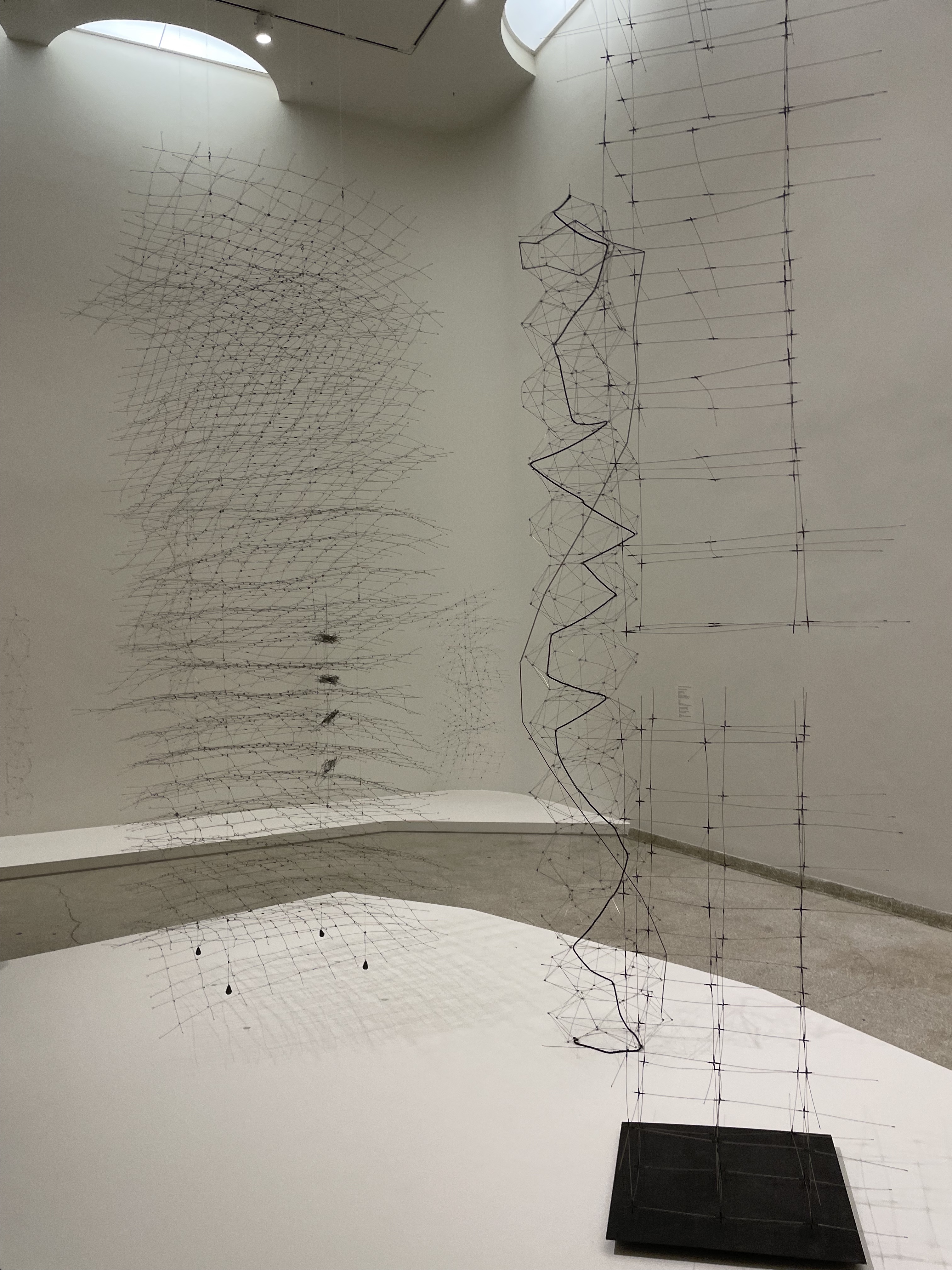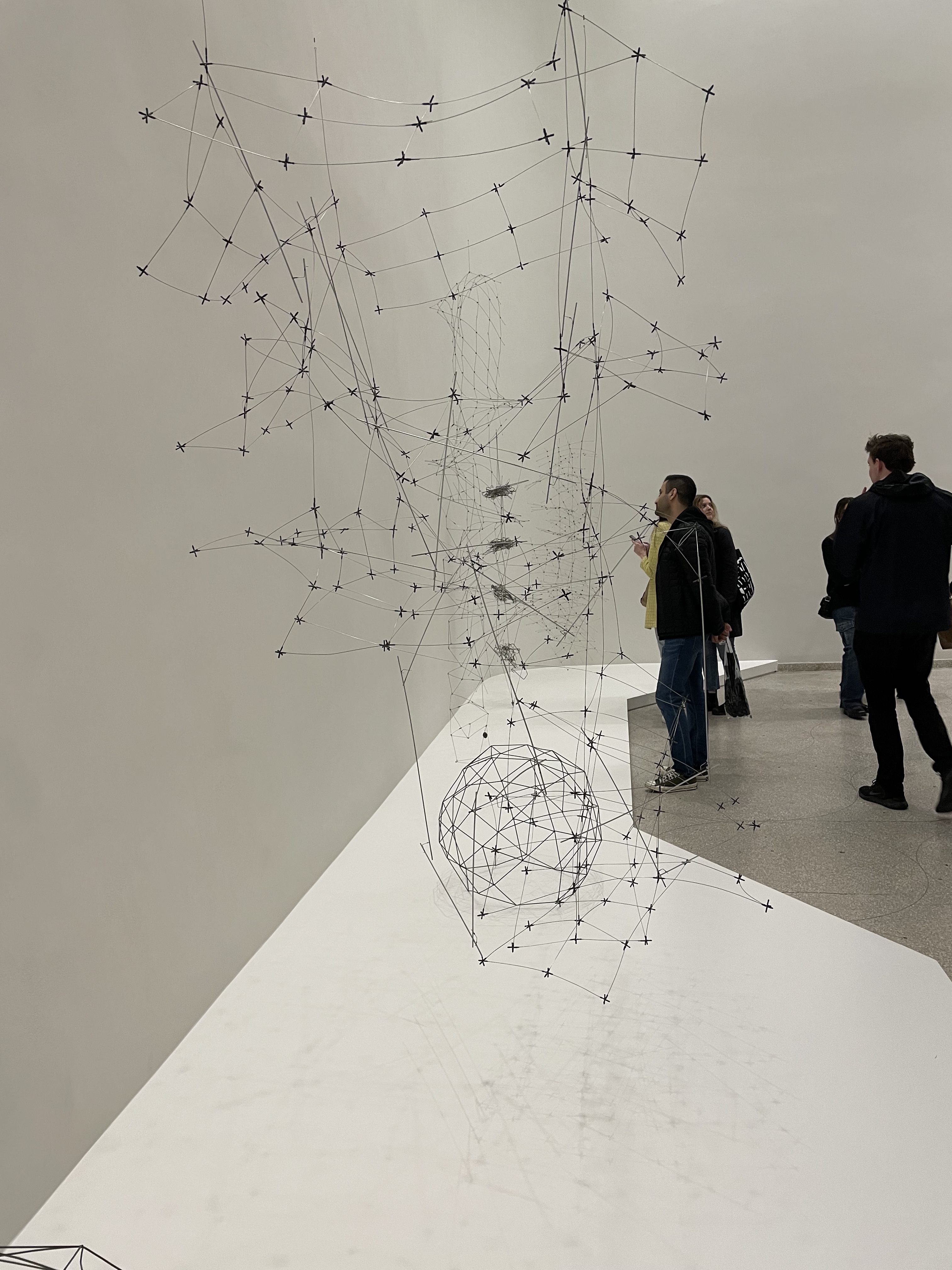Imagining Infinity — Gego
Occupying nearly the entirety of New York’s iconic Solomon R. Guggenheim Museum, the exhibition Gego: Measuring Infinity (showing from March 31st to September 10th, 2023) is a major retrospective on the complete works of artist Gertrud Louise Goldschmidt (1912 – 1994), whose moniker is “Gego.” This exhibition, according to Richard Armstrong, the Director of the Guggenheim, aims to “make clear the development of the German-Venezuelan artist’s unique language of abstraction across various mediums, including sculpture, drawing, prints, artist’s books, and textiles .” (Gutiérrez-Guimarães, Léon, 2023 pg 11) The curators, Pablo León de la Barra and Geaninne Gutiérrez-Guimarães, effectively utilize the architecture of the space to craft a compelling narrative of Gego’s artistic development. Rotunda by rotunda, we see Gego develop ideas across time, and mediums that culminate in her iconic gravity-defying, hanging, netlike, wired sculptures called Reticulárea.
Gego measures infinity for us to imagine it. The curators’ efforts, particularly through repetition, lighting, and movement, prime viewers to “Imagine Infinity” in the full conceptual and socio-political frame Gego intended us to. Infinity is a primordial spiritual, mathematical, and philosophical concept, with political significance. Gego has dedicated her artworks to exploring it. This synthesis of curatorial and artistic intent creates a tangible electric atmosphere for laypersons and experts alike — a rarity for modern art.
Knowing full well that “audiences in the United States have had little opportunity to see and experience [Gego’s work] in depth,” the curators take full control of the frame through which viewers experience Gego (Gutiérrez-Guimarães, Léon, 2023 pg 11). The rotunda structure enforces both order and movement through the exhibition. Each rotunda is centered around a theme and a period, which narrates a periodized story of Gego’s development.
Upon walking up the first ramp, viewers are greeted with a short introduction to the exhibit. Here we are given a sense of the aims of the exhibit and a biographical sketch. However, though they promise a chronological story, they immediately break it. The viewer is thrown in, en media res, into a tall two-storied room known as the High Gallery with towering forms of Gego’s iconic Reticulárea sculpture. Reticulárea is a style of sculpture where thin aluminum wires are connected to create squares and triangles and then assembled in a net-like structure. Gego uses local reputation and minor variation to create shapes and distort space. It is a form that challenges sculpture as a heavy, grounded, and subtractive form with its airy, hanging, additive form. Described by Gego as “drawing without paper,” the style uses minimal lines to carve up and shape space. Viewers are shown, rather than told, what “non-objective art” is. Gego uses geometric abstraction not as a means to represent objects in the world but as an exploration of geometric forms for its own sake. The High Gallery sets the stage for the rest of the story. This decision drew in viewers (this was prime selfie real estate) and creates intrigue. The curators didn’t explain the form — they showed it.


Up the Rotundas
The first rotunda, Early Works (1953–60), is largely historic in its function, showing a number of prints and paintings flat along the wall. A watercolor landscape painting of the Caracas mountain line, prints of landscape, and an abstract painting of a house. We get a clear sense of how Gego’s early works are informed by her training as an engineer and architect and how her sense of place and home is shaped as an immigrant to Venezuela, fleeing Nazi Germany. As I will argue later, these two concepts of mathematics and politics are important to her concept of Infinity. We are also introduced to the variety of media that Gego has to work with. These are her tools to render the infinite.
The second rotunda, Parallel Lines (1957-68), shows a clear turn to geometric abstraction and from 2-D to 3-D sculpture. The metal materiality not only rebukes gendered norms around sculpture but also nods to the rapid industrialization of Venezuela during this period. Through parallel lines, negative space, and a moving viewer, Gego creates the optical illusion of movement. Kinetic art, artworks with an element of movement perceivable to the viewer, are animated by the viewer’s movement up the rotunda. Gego’s work continues to be Kinetic, and the source of the movement continues to remain with the viewer. Still, as I will argue, it becomes more psychological and less physical with Reticulárea.
Finally, on the fourth rotunda, “Chorros, Troncos, and Esferas”(1970-1977), we see the familiar Reticulárea from the High Gallery. Except this time, with greater awareness of the steps Gego took to get here and the influences on the style. Furthermore, the repetition of the form and its smaller sizes creates a familiarity that invites us to look more closely. We are now ready to “Imagine Infinity.” To explain how I use two of Gogo’s works that create a surface that stimulates and calls us to Imagine Infinity based on concrete geometric processes.
Reticulárea

Both works are Sin Título (Untitled), the first watercolor on graphite paper from 1980 (Appendix, Figure A), and the second a 3-D Reticulárea and hanging sheet (Appendix, Figure B). Both are from the fifth and final rotunda, called “Dibujos sin papel” (Drawings without paper). Ironically, the first untitled work is on paper and part of a collection called Reticulárea Watercolors. Gego studies the form meant to transcend paper on paper. The colorful lines, foregrounded solid red, contrast the solid shapes filled with shades of blue. The negative space of the solid shapes forms a network of triangles that connect with the red lines. This adds to the dual impression of the painting as both flat and deep. The emptiness in the top right and bottom left add to the depth. However, unlike the depth created by a simple linear perspective, this depth is not fully optical. Gego creates space by asking us to imagine it. To imagine higher and lower dimensions. Using lines, shaded, negative, solid interwoven, and emptiness to stimulate our imagination. In contrast, the second rotunda, where physical movement gives the work movement, is now the psychological movement of the mind that gives these works life. The role of the viewer and their imagination is central to Gego’s broader artistic project.
 This second piece is a sheet in the Reticulárea style. Its simplicity in shape reveals its complexity. Gego’s use of wire, a light material she could bend with her hands, allowed her to distort and play with space. However, sticking to rigid geometric shapes and repeating them with slight distortions mixing triangles and squares along the creases of the sheet, create movement and modulation in space in a paradoxically rigid and flexible way. Gego synthesizes opposing forms — drawing and sculpture — and by “drawing without paper,” she expands our imagination of forms. This style overcomes many dichotomies of fragility and fluidity, surface and negative space, and between the finite and infinite.
This second piece is a sheet in the Reticulárea style. Its simplicity in shape reveals its complexity. Gego’s use of wire, a light material she could bend with her hands, allowed her to distort and play with space. However, sticking to rigid geometric shapes and repeating them with slight distortions mixing triangles and squares along the creases of the sheet, create movement and modulation in space in a paradoxically rigid and flexible way. Gego synthesizes opposing forms — drawing and sculpture — and by “drawing without paper,” she expands our imagination of forms. This style overcomes many dichotomies of fragility and fluidity, surface and negative space, and between the finite and infinite.
Gego renders infinity through her repetition of simple shapes. She shows us a process of creation, connecting triangles and rectangular shapes that bend space, which can be repeated forever. To imagine infinity, our mind must extend that process infinitely, and then the surface becomes infinite. With a single infinity in mind, we can easily generate infinitely more infinities. The overhead lighting and the shadow cast on the back of the wall serve as a visual reminder of that possibility. The curators, no doubt, chose this lighting and kept the white walls to clearly render the shadow, which in mathematical terms, is a projection from a 3-D object onto a 2-D plane. The shadow is a visual function from a higher dimension to a lower dimensional space. It illustrates the fundamental idea of a function as a map between input and output, but also anxiety within mathematics. Namely, writing and working with vectors of high dimensional space is easy to notate but impossible to visualize in space. The same is true of working with infinities. Mathematics loses its concreteness, becoming less human. Abstraction can become an end in itself.
However, Gego reminds us that though there is beauty — conceptual and aesthetic — in abstraction, the human subject is its constitution and ultimate end. Abstraction requires the imagination both to create and interpret. Often the infinite is used to eliminate the individual. Whose infinity are we part of? Who isn’t? While some might argue that this leap to political might is unwarranted, we must not forget that Gego had to flee Nazi Germany, and Nazi Germany weaponized art like no other nation-state.
 Her use of metals is no doubt a testament to the increasing industrialization but also to the function of wires as conduits for electricity and the antenna-like structures of radio signal towers. Modulation and undulation, the kind of movement Gego tries to create, are associated with waves. She is no doubt calling our attention to the radio. At the time of WWII, the duality of radio in its capacity to expand imagination and disseminate propaganda was a potent political topic. Gego’s manipulation of wire draws attention to the tools we have to imagine and reimagine society. By participating in Gego’s artwork, we see and feel the endless modulation of these netlike structures and use them as the basis for the imagination of infinity. The fact her language of abstraction is rooted in concrete geometric processes, which are comprehensible and therefore mouldable by humans, has a subtle but powerful political message for its viewers.
Her use of metals is no doubt a testament to the increasing industrialization but also to the function of wires as conduits for electricity and the antenna-like structures of radio signal towers. Modulation and undulation, the kind of movement Gego tries to create, are associated with waves. She is no doubt calling our attention to the radio. At the time of WWII, the duality of radio in its capacity to expand imagination and disseminate propaganda was a potent political topic. Gego’s manipulation of wire draws attention to the tools we have to imagine and reimagine society. By participating in Gego’s artwork, we see and feel the endless modulation of these netlike structures and use them as the basis for the imagination of infinity. The fact her language of abstraction is rooted in concrete geometric processes, which are comprehensible and therefore mouldable by humans, has a subtle but powerful political message for its viewers.
Reaching the top of the museum, after having gone through the curated journey, I couldn’t help but think that no other museum could pull off this narrative. The curators build this exhibit around the architecture. As such, Gego’s work and her development have forever changed, stimulated, and expanded my capacity to Image Infinity and the tools one can use to do this tragically human task.
References:
Gutiérrez-Guimarães, G. and Pablo, L. de la B. (2023) Gego: Measuring infinity. New York, NY: Guggenheim.
Gego: Measuring infinity (no date) The Guggenheim Museums and Foundation. Available at: https://www.guggenheim.org/exhibition/gego-measuring-infinity (Accessed: 03 May 2023)